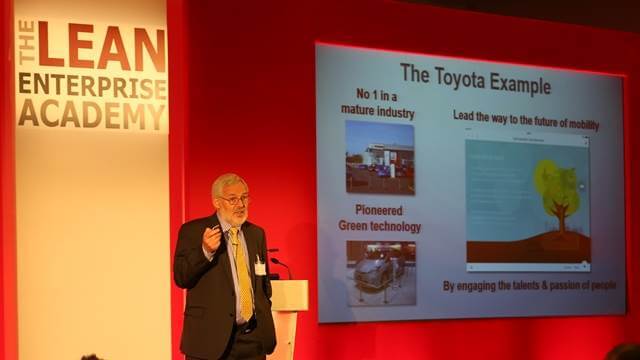In our Lean Summits we are always focused on deepening our insights into the frontiers of Lean practice. We aim to provide real food for those seriously engaged in Lean transformations, which you will not find in any other Lean conference.
At last years’ Summit I spoke about six ways in which Lean can contribute to shaping the digital age we are now entering. You can consider each of these in turn or watch the whole 35 minute talk.

Legacy Assets and Mind-sets. We need to move from improving the big legacy assets of the mass production era to developing next generation solutions. We also need to move beyond the Taylorist legacy mind-set of change designed by experts for compliance by employees to engaging everyone.
The Toyota Example. Cumulative Kaizen plus deep technical knowledge plus a big vision of the future led Toyota to dominate a mature industry, then to redefine the technology combining hardware and software and now to creating the mobility systems of the future. It remains a relevant reference model for the digital age.
Digital Disruption. The realisation of the potential of digital technologies depends on finding new social and organisational forms that engage knowledgeable employees and on getting frequent and rapid feedback from users. Lean, Agile and Lean Startup together point the way to what is possible.
Lean Learning. The core of Lean is repeated practice in using the scientific approach in order to learn how to solve tomorrows’ problems. Leading Lean is about learning to face, find and frame the underlying business problems through coaching the front-line in solving their problems. We learn as they learn.
Managing Streams. Many industries are moving from managing projects to managing streams, encompassing design, production, delivery and ongoing support. The inspiring Spotify example shows a new way to organise teams to focus on purpose, deepen their technical knowledge and work together effectively, supported by management.
Engaging Users. We must learn to think back from how users solve their problems rather than thinking “what can I sell them”. Elastera is an example of a start-up where user experience determines the product and features. The Saskatchewan example shows how 3P captures the process capabilities of staff and patients in designing a next generation hospital, with big savings in capital and running costs.
The Challenges. Can we act our way to the Digital Age? Can learning through Kaizen beat big leaps? Can Lean help design organisations of the future? My answer is yes.
This year Dave Brunt has asked me to talk about different approaches to Lean transformation and how they challenge us to think differently about leading and supporting them.
 In addition we will be joined by two of the most inspiring examples I visited last year. Kristian Lindwall from Spoitfy will share their experience in organising and supporting effective teams in the digital age. The team from Garraff Hospital in Barcelona will describe how you can learn from their “do-it-yourself” approach to developing a problem solving culture with limited mentoring support.
In addition we will be joined by two of the most inspiring examples I visited last year. Kristian Lindwall from Spoitfy will share their experience in organising and supporting effective teams in the digital age. The team from Garraff Hospital in Barcelona will describe how you can learn from their “do-it-yourself” approach to developing a problem solving culture with limited mentoring support.
Do join us in November – visit www.leanuk.org/leasummit2015 for more details.